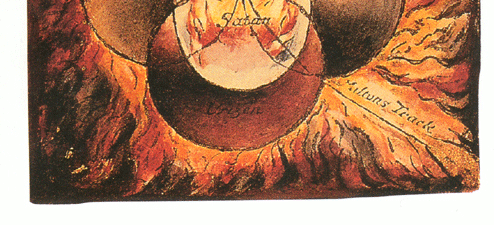the NachtKabarett
All Writing & Content © Nick Kushner Unless Noted Otherwise
 Image of the 'Eden Eye' which Manson mused in Coma Black, as found in the Holy Wood album artwork
Image of the 'Eden Eye' which Manson mused in Coma Black, as found in the Holy Wood album artwork
WORDS by Anne Sexton (excerpt) |
Coma Black Track 15 on Holy Wood |
The following is a presentation of the imagery which appears within the artwork of Holy Wood and their corresponding lyrics which Manson sung in 'Coma Black'. For an overview of the concept of Coma White / Black within the story Manson outlined within the Triptych of Antichrist Svperstar, Mechanical Animals and Holy Wood, see the Coma White section of The NACHTKABARETT.
 Original source
Original sourceAlchemy & Mysticism: The Hermetic Museum by Alexander Roob"Large parts of William Blake's poetry are concerned with a detailed engagement with Isaac Newton's materialist view of the world, particularly his optics. In Blake's view the physical eye is dull and dim 'like a black pebble in a churning sea,' and the optic nerve, to which Newton pays homage, 'builds stone bulwarks against the raging sea.' (Blake, Milton, 1804) Blake instead turned to the work of Jacon Böhme, and attempted to develop an optics of the visionary.
"According to the hypothesis of Easson and Easson, which fails to take into account many aspects of the poetry, every level of Blake's poem 'Milton' is based on an optical model, inscribed within the form of the cosmic egg.
"K.P. Easson and R.R. Easson, A hypothetical model for the visionary geography in 'Milton,' from W. Blake, Milton, London, 1979"
 |
 |
 |
Alchemy & Mysticism: The Hermetic Museum by Alexander Roob"The four intersecting globes are inscribed with the names of the four Zoas, the apocalyptic creatures that represent the elemental forces of the universe. Urthona/Los is the imagination, Luvah passion, Urizen reason and Tharmas the body.
"'The egg-shaped world of Los,' which swells from the swirling centre of chaos, forms the illusory three-dimensional space defined by the two boundaries of opacity (Satan) and material condensation (Adam). They obstruct man's free vision of things as they really are according to Blake, namely eternal and infinite.
"W. Blake, Milton, 1804-1808"
NK Note - Note the derivation for the sectioning of the Egg/Eye above which appeared in Holy Wood with Adam represented above and Satan being represented below.
 Image of the 'Blood Stained Egg' which Manson sung about in Coma Black, as found in the Holy Wood album artwork
Image of the 'Blood Stained Egg' which Manson sung about in Coma Black, as found in the Holy Wood album artwork Original source
Original sourceAlchemy & Mysticism: The Hermetic Museum by Alexander Roob"The astronomer and mathematician John Dee (1527-1608) used the egg as a glyph for the ethereal heavens, because the orbit of the planets within it forms an oval. (Even Copernicus assumed that planetary orbits were circular.)
"For Paracelsus 'the sky is a shell which separates the world and God's heaven from one another, as does the shell the egg.' The yolk represents the lower sphere, the white the upper; the yolk: earth and water, the white: air and fire.' (Paragranum, 1530)
"John Dee, Mona Hieroglyphica, Antwerp, 1564"

Alchemy & Mysticism: The Hermetic Museum by Alexander Roob"According to Fludd, 'the monochord is the is internal principle which, from the centre of the whole, brings about the harmony of all like in the cosmos.'
"By altering the tension of the strings, God, the 'Great Chord,' is able to determine the density of all materials between Empyreum and Earth.
"The instrument is divided in half into an upper, ideal, active octave and a lower, material, passive octave, and these are in turn divided into fourths and fifths. On these intervals the upper, principle of light moves down into dark matter, and at their intersection the sun assumes the power of transformation.
"R. Fludd, Utriusque Cosmi, Vol. I, Oppenheim, 1617"
NK Note - Note the identical hierarchy of the 7 Alchemical elements as on the Egg and the parallels between the microcosm of delineations to the concept of The Four Worlds Of Kabbalah discussed above.
 |
 |
| Two of the flashing symbols on the main menu of the Guns, God & Government DVD. | |
I burned all the good things in the Eden Eye
We were too dumb, to run too dead to die
Coma Black Track 15 on Holy Wood
(excerpt)

Alchemy & Mysticism: The Hermetic Museum by Alexander Roob"I the medieval view, the eye consisted of three different forms of condensation of physical fluid. According to the theory of the Arabian scholar Avicenna (980-1037), an icy fluid forms the centre of the eye. In front of it is the watery area, behind it is the crystalline area. It is clad in seven robes or skins (tunicas), to which the seven planetary spheres correspond in the macrocosm. The Cabalists connected this ten part structure of the eye with the Sephiroth. The blind spot was a term applied to the high Sephira "Kether", the crown, or the divine void in all things.
"Gregor Reisch, Pretiosa Margarita, Freiburg, 1503; Basle, 1508"
